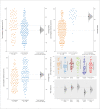Assessing the Readiness to Provide Integrated Management of Cardiovascular Diseases and Type 2 Diabetes in Kenya: Results from a National Survey
- PMID: 37334400
- PMCID: PMC10275139
- DOI: 10.5334/gh.1213
Assessing the Readiness to Provide Integrated Management of Cardiovascular Diseases and Type 2 Diabetes in Kenya: Results from a National Survey
Abstract
Introduction: Integrated chronic disease management is the desired core function of a responsive healthcare system. However, many challenges surround its implementation in Sub-Saharan Africa. The current study assessed the readiness of healthcare facilities to provide integrated management of cardiovascular diseases (CVDs) and type 2 diabetes in Kenya.
Methods: We used data from a nationally representative cross-sectional survey of 258 public and private health facilities conducted in Kenya between 2019 and 2020. Data were collected using a standardised facility assessment questionnaire and observation checklists modified from the World Health Organization Package of Essential Non-communicable Diseases. The primary outcome was the readiness to provide integrated care for CVDs and diabetes-defined as the mean availability of tracer items comprising trained staff and clinical guidelines, diagnostic equipment, essential medicines, diagnosis, treatment and follow-up. A cut-off threshold of ≥70% was used to classify facilities as 'ready'. Gardner-Altman plots and modified Poisson regression were used to examine the facility characteristics associated with care integration readiness.
Results: Of the surveyed facilities, only a quarter (24.1%) were ready to provide integrated care for CVDs and type 2 diabetes. Care integration readiness was lower in public versus private facilities [aPR = 0.6; 95% CI 0.4 to 0.9], and primary healthcare facilities were less likely to be ready compared to hospitals [aPR = 0.2; 95% CI 0.1 to 0.4]. Facilities located in Central Kenya [aPR = 0.3; 95% CI 0.1 to 0.9], and the Rift Valley region [aPR = 0.4; 95% CI 0.1 to 0.9], were less likely to be ready compared to the capital Nairobi.
Conclusions: There are gaps in the readiness of healthcare facilities particularly primary healthcare facilities in Kenya to provide integrated care services for CVDs and diabetes. Our findings inform the review of current supply-side interventions for integrated management of CVDs and type 2 diabetes, especially in lower-level public health facilities in Kenya.
Keywords: cardiovascular diseases; integrated care; readiness assessment; type 2 diabetes.
Copyright: © 2023 The Author(s).
Conflict of interest statement
The authors have no competing interests to declare.
Figures





Similar articles
-
Readiness of health facilities to deliver non-communicable diseases services in Kenya: a national cross-sectional survey.BMC Health Serv Res. 2022 Aug 2;22(1):985. doi: 10.1186/s12913-022-08364-w. BMC Health Serv Res. 2022. PMID: 35918710 Free PMC article.
-
Health system's readiness to provide cardiovascular, diabetes and chronic respiratory disease related services in Nepal: analysis using 2015 health facility survey.BMC Public Health. 2020 Jul 25;20(1):1163. doi: 10.1186/s12889-020-09279-z. BMC Public Health. 2020. PMID: 32711487 Free PMC article.
-
Readiness of health facilities to provide services related to non-communicable diseases in Nepal: evidence from nationally representative Nepal Health Facility Survey 2021.BMJ Open. 2023 Jul 9;13(7):e072673. doi: 10.1136/bmjopen-2023-072673. BMJ Open. 2023. PMID: 37423630 Free PMC article.
-
Health System Capacity and Access Barriers to Diagnosis and Treatment of CVD and Diabetes in Nepal.Glob Heart. 2021 May 18;16(1):38. doi: 10.5334/gh.927. Glob Heart. 2021. PMID: 34040951 Free PMC article.
-
Health system readiness for non-communicable diseases at the primary care level: a systematic review.BMJ Open. 2022 Feb 9;12(2):e060387. doi: 10.1136/bmjopen-2021-060387. BMJ Open. 2022. PMID: 35140165 Free PMC article.
Cited by
-
Blood transfusion service readiness and its associated factors in health facilities providing blood transfusion services across Ethiopia: A secondary analysis of the 2018 Service Availability and Readiness Assessment (SARA) survey.PLoS One. 2024 Dec 12;19(12):e0315665. doi: 10.1371/journal.pone.0315665. eCollection 2024. PLoS One. 2024. PMID: 39666720 Free PMC article.
-
Perceived health system facilitators and barriers to integrated management of hypertension and type 2 diabetes in Kenya: a qualitative study.BMJ Open. 2023 Aug 11;13(8):e074274. doi: 10.1136/bmjopen-2023-074274. BMJ Open. 2023. PMID: 37567749 Free PMC article.
-
Readiness of primary healthcare and community markets for joint delivery of cardiovascular disease prevention services in Kenya: an observational feasibility study of Health Kiosks in Markets (HEKIMA).BMJ Open. 2024 Nov 19;14(11):e081993. doi: 10.1136/bmjopen-2023-081993. BMJ Open. 2024. PMID: 39566940 Free PMC article.
References
-
- GBD 2015 Risk Factors Collaborators. Global, regional, and national comparative risk assessment of 79 behavioural, environmental and occupational, and metabolic risks or clusters of risks, 1990–2015: a systematic analysis for the Global Burden of Disease Study 2015. The Lancet. 2016; 388(10053): 1659–1724. DOI: 10.1016/S0140-6736(16)31679-8 - DOI - PMC - PubMed
-
- Wang H, Naghavi M, Allen C, Barber RM, Bhutta ZA, Carter A, et al. Global, regional, and national life expectancy, all-cause mortality, and cause-specific mortality for 249 causes of death, 1980–2015: a systematic analysis for the Global Burden of Disease Study 2015. The Lancet. 2016; 388(10053): 1459–1544. DOI: 10.1016/S0140-6736(16)31012-1 - DOI - PMC - PubMed
-
- World Health Organization (WHO). Noncommunicable diseases: progress monitor 2020. Geneva: WHO; 2020.
-
- Kenya National Bureau of Statistics (KNBS). Kenya STEPwise survey for non communicable diseases risk factors 2015 report. Nairobi, Kenya: KNBS; 2015.
-
- Zhou B, Bentham J, Di Cesare M, Bixby H, Danaei G, Cowan MJ, et al. Worldwide trends in blood pressure from 1975 to 2015: a pooled analysis of 1479 population-based measurement studies with 19.1 million participants. The Lancet. 2017; 389(10064): 37–55. DOI: 10.1016/S0140-6736(16)31919-5 - DOI - PMC - PubMed
Publication types
MeSH terms
LinkOut - more resources
Full Text Sources
Medical
Miscellaneous

